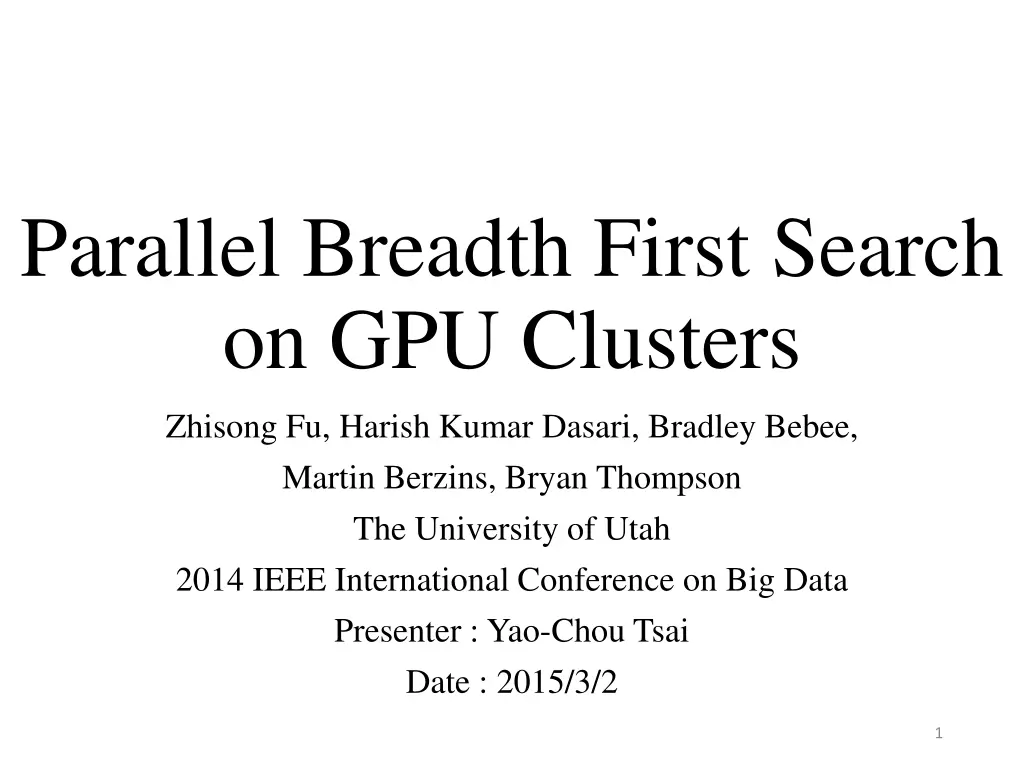
Fast Parallel Breadth First Search on GPU Clusters
"Learn about the efficient execution of parallel graph algorithms using Breadth First Search on GPU clusters, leveraging high FLOPS/watt and memory bandwidth advantages. Explore how GPUs can create a high-performance parallel graph machine with commodity hardware."
Download Presentation

Please find below an Image/Link to download the presentation.
The content on the website is provided AS IS for your information and personal use only. It may not be sold, licensed, or shared on other websites without obtaining consent from the author. If you encounter any issues during the download, it is possible that the publisher has removed the file from their server.
You are allowed to download the files provided on this website for personal or commercial use, subject to the condition that they are used lawfully. All files are the property of their respective owners.
The content on the website is provided AS IS for your information and personal use only. It may not be sold, licensed, or shared on other websites without obtaining consent from the author.
E N D
Presentation Transcript
Parallel Breadth First Search on GPU Clusters Zhisong Fu, Harish Kumar Dasari, Bradley Bebee, Martin Berzins, Bryan Thompson The University of Utah 2014 IEEE International Conference on Big Data Presenter : Yao-Chou Tsai Date : 2015/3/2 1
Abstract(1/2) Fast, scalable, low-cost, and low-power execution of parallel graph algorithms is important for a wide variety of commercial and public sector applications. Breadth First Search (BFS) imposes an extreme burden on memory bandwidth and network communications and has been proposed as a benchmark that may be used to evaluate current and future parallel computers. Hardware trends and manufacturing limits strongly imply that many-core devices, such as NVIDIA GPUs and the Intel Xeon Phi , will become central components of such future systems. 2
Abstract(2/2) GPUs are well known to deliver the highest FLOPS/watt and enjoy a very significant memory bandwidth advantage over CPU architectures. Recent work has demonstrated that GPUs can deliver high performance for parallel graph algorithms and, further, that it is possible to encapsulate that capability in a manner that hides the low level details of the GPU architecture and the CUDA language but preserves the high throughput of the GPU. We extend previous research on GPUs and on scalable graph processing on supercomputers and demonstrate that a high-performance parallel graph machine can be created using commodity GPUs and networking hardware. 3
References 1. MapGraph: A High Level API for Fast Development of High Performance Graph Analytics on GPUs; 2014 2. Parallel Breadth-First Search on Distributed Memory Systems; 2011 3. Breaking the speed and scalability barriers for graph exploration on distributed-memory machines; 2012 4. Parallel Breadth First Search on GPU Clusters; 2014 4
Conception Alice Sue Bob Mary 4 vertices, 3 edges 5
Why? 1. BFS a. b. Least work per byte The most reliance on memory bandwidth within the node while placing a severe stress on the communications network among the nodes. 2. GPUs a. High performance : NVIDIA K40 => 1.43 Tflops b. High energy efficieny 6
BFS(Breadth first search)(2/3) 1 procedure BFS(G,v) is 2 let Q be a queue 3 Q.push(v) 4 label v as discovered 5 while Q is not empty 6 v Q.pop() 7 for all edges from v to w in G.adjacentEdges(v) do 8 if w is not labeled as discovered 9 Q.push(w) 10 label w as discovered 8
BFS(Breadth first search)(3/3) Explain: It is a graph search algorithm that begins at the root vertex and explores all the connected vertices, traversing all vertices of a particular level before traversing the vertices of the next level. 1. At the end of the BFS we can find out the level of a vertex if it is connected to the root element and also its predecessor. 2. Useful in social media, logistics and supply chains, e- commerce, counter-terrorism, fraud detection etc. 9
GAS abstraction(1/3) Gather : The Gather phase collect information from the 1-hop neighborhood of a vertex using a generalized binary operator to perform a parallel reduction over the 1-hop edges and vertices in that 1-hop neighborhood. 10
GAS abstraction(2/3) Apply : The Apply phase integrates the information from the Gather phase, updating the state of the vertex. In the picture, the red vertices are the active vertices. Their state may change as a result of the apply operation. 11
GAS abstraction(3/3) Scatter : The Scatter phase redistributes information to the 1-hop neighborhood of a vertex. Again the red vertices are the active vertices. You can see that their state has changed. This change occurred during the Apply phase (above). The little (i) icons show the movement of messages along the edges leading to the 1-hop neighbors of the active vertices. 12
Compressed Sparse Row(CSR)(1/2) 1 0 5 0 7 2 0 6 0 8 3 0 0 0 9 4 Row offsets 0 2 4 7 9 Column indices 0 1 1 2 0 2 3 1 3 Values 1 7 2 8 5 3 9 6 4 13
Compressed Sparse Row(CSR)(2/2) Row offsets A B C D B D D C 1 3 4 5 Values B C D D Column indices 1 2 1 1 14
Experimental setup 32 nodes and 64 NVIDIA K20c GPUs with 5GB DDR5 memory Two Mellanox InfiniBand SX6025 cards per node CUDA 5.5 used for these results Used GPUDirect support in MVAPICH2-GDR to avoid explicit copy of messages to host memory 20
Results 1. Strong scaling : The scale of the problem remains the same as we increase the computational resources (GPUs) GTEPS= Giga(Billion) Traversed Edges Per Second = 109edges per second 21
Results 2. Weak scaling: Problem size grows proportional to the growth in computational resources (GPUs) 22
Results 23
